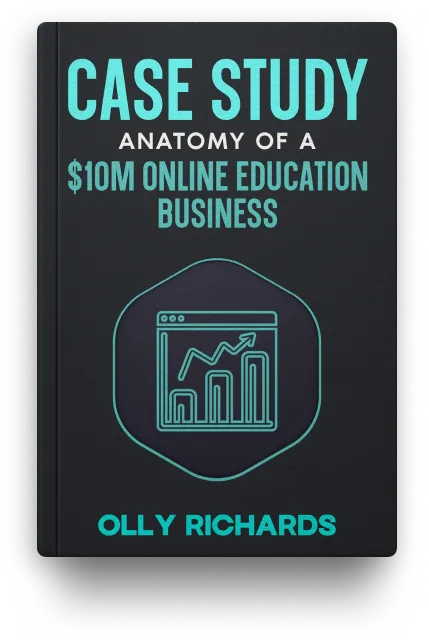Recently, I ran a webinar on “AI, Google and the Future of Course Businesses”.
You know, the one where I had the tech meltdown?
🙂
Anyway…
One of the core premises of that webinars was:
The future (of education businesses) is going to look VERY different than it has in the last 10 years.
The causes are varied:
- Google isn’t dishing out traffic like it used to
- People are not “collecting” courses like they used to
- Email isn’t even getting opened like it used to
(If this is news to you, you can catch the replay of this webinar here)
I think these challenges are actually going to weed out a lot of inefficient players.
Like a digital Marie Kondo.
And so, one of the biggest challenges for established businesses in the next few years is gonna be:
Rethinking your entire business from top to bottom to become more efficient.
But wait — weren’t online businesses always efficient? (Compared to restaurants or whatever.)
Some were.
But a lot weren’t .
I’ve always preached that online education businesses need margins of at least 30%… ideally 40-50%.
And one of the reasons for that is so you’re able to absorb shocks.
Those who have been running 10-20% margins are running a permanent risk of being put out of business by one major change.
Example: Your CAC on Facebook suddenly doubles… there’s your margin gone up in a puff of smoke.
But…
Despite all the disruption, there’s also lots of opportunity.
Those who survive this disruption will emerge stronger than ever, like a cockroach surviving the apocalypse.
Here’s why…
See, despite the changes…
- People are still spending money
- They’re still buying education products
- Often, they’re spending much more than before
So, there’s plenty of opportunity… but the way we do business is changing.
So you’ve got to be aware of this…
And make sure you’re stable enough to ride out this period of disruption.
(Again, if you want detail on this, just go back and watch the webinar.)
I’ve been talking about this a lot with 7-figure business owner friends recently, and we’re all coming to the same conclusion:
- You can’t afford to carry large overheads like before
- You have to cut down bloated teams
- You have to make maximum use of AI and automation to run your core processes
- Your team moving forward will consist of a smaller number of highly skilled humans to provide the sprinkling of magic
Examples of cost centres that can be already rebuilt with AI:
- Repurposing content
- Creating graphics
- Transcription
- Customer support
- Email marketing
In particular, anything that involves (or is powered by) text or image processing.
To be clear:
These things still need to be done, and the expert touch still needs to be present on the final product, but you can use AI to do a lot of the heavy-lifting, and therefore do it a lot more cheaply.
I think a sensible approach is this:
If you currently operate with 30% net margins, aim to increase that to 50% by rebuilding with AI and automation.
It’s a big job, but that will make you hella-resilient moving forward.
(We’ve just finishing up this work at StoryLearning, for example, and managed to eke out around a 15% margin gain.)
You can’t afford NOT to take advantage of these savings in the years to come, or your business model will soon be obsolete.
Here’s an example of how this might work.
Take customer support…
A customer writes in with a question: “Is your product right for me, given XYZ circumstances?”
The old way:
- Agent carefully reads question
- Checks with team about this customer’s specific case
- Pulls up a template response
- Spends 20 mins customising it and hits send
Total time: 45 mins
The new way:
- AI reads the entire history of customer support queries (which it has stored in a knowledge base)
- Prepares a personalised response, addressing every aspect of the question
- If it has an 80%+ confidence score in the response, sends it immediately. Otherwise, saves response in drafts.
- CS agent comes in at 9am, quickly checks it, hits send.
Total time: 1 min
Many online businesses that came up in the 2010s built big teams to run their operations.
And it worked, because the economics of digital product businesses could support these teams.
The future is going to look quite different.
Heck, it’s already different.
The key point is:
AI is not an “add-on”. You need to rebuild your business processes to use AI and automation at the core.
Frankly, this is easier for newer businesses, because you can build this way from the start.
Established businesses will have a harder time, because you have to undo, or relearn your way of doing things.
Lastly, you can’t automate away your entire business.
Despite what you see on social media, armies of AI agents are not coming to run your entire business any time soon.
But, particularly in the text-driven areas I mentioned above, “one smart person + AI” can now do the work of 2-3 people.
The key is to have 2-3 really good people, so that you can still maintain that creative edge.
The future will belong to businesses that can combine the efficiency of AI and automation, with the magic touch of smart humans.
Namaste,
Olly

